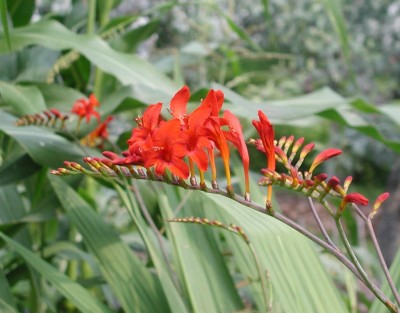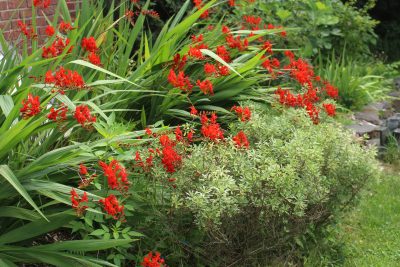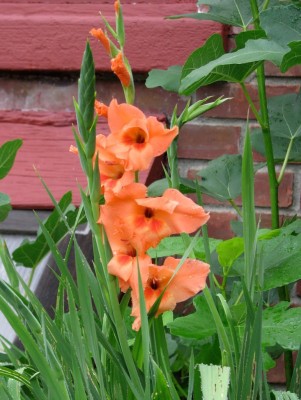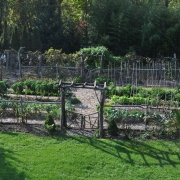Of Crocs and Glads
No-Dig Crocs
Plants grow and multiply, which sometimes causes trouble. Such trouble was highlighted this week as I was digging up my crocosmia bulbs.
 Backpedaling perhaps 20 years, you would have found me ordering crocosmia bulbs from a mail-order catalog. I’d seen the plants blooming in a friend’s garden in New Jersey and marveled at the graceful flower stems that arched up and out from clumps of sword-shaped leaves. Lined up near the ends of each flower stalk were pairs of tubular, hot scarlet blossoms.
Backpedaling perhaps 20 years, you would have found me ordering crocosmia bulbs from a mail-order catalog. I’d seen the plants blooming in a friend’s garden in New Jersey and marveled at the graceful flower stems that arched up and out from clumps of sword-shaped leaves. Lined up near the ends of each flower stalk were pairs of tubular, hot scarlet blossoms.
Crocosmia isn’t supposed to be cold-hardy outdoors where winter temperatures drop below minus 10 degrees F. (hardiness zone 5), so the first couple of autumns, as instructed, I dug up the bulbs for winter storage. Each spring following, the plants would get off to a slow start, finally blooming late in the season or not at all.
In disappointment or laziness, I stopped digging the bulbs up each fall. I was surprised to see them appear in spring anyway. Not only did they appear in spring; they had some real oomph, growing almost as luxuriantly as the ones in my friend’s garden. To make matters better, they started blooming earlier, in July, and in great profusion, and they have done so reliably year after year with no help at all from me.
The crocosmias also multiplied, and they did so with such enthusiasm that there became just too many of them at the original location. So I started digging. And I uncovered bulb after bulb after bulb, ready to bloom and multiply next year. Now I have to decide what to do with all those bulbs. Plant them? Give them away? Compost them? I would have never thought I could have had too many crocosmias.
Glads Won’t Die
Does anybody around here still dig up their gladiolas each fall? I don’t, but to no avail. Left outside, they still survive every winter. Yuk. (Gladiolus “bulbs” are, like crocosmia “bulbs,” actually bulb like structured called “corms.”)
I don’t like gladiolas. Perhaps it’s because they are the most popular flower for funerals.
At any rate, I did, for some reason, plant some glads over 30 years go, glads whose beautiful salmon, pink color I subsequently felt was wasted on glad flowers. The nice color couldn’t outweigh the funereal associations, so after a couple of years of digging them up for storage each fall, I decided to sacrifice them to winter cold.
Unfortunately, they reappeared each year, and have continued to do so annually. I have to chuckle whenever I read instructions such as: “Corms should be dug after foliage has matured and started turning brown. Lift corms carefully with a spade or spading fork, taking care not to cut into the corm. Cut the tops off 1inch above the corm and dry for 2 to 4 weeks in a warm location (70-80 degrees Fahrenheit) with good air circulation. Remove the old corm which is beneath the new corm. Discard any rotted or damaged corms. Cut stems back to within an eighth of an inch of the corm. Place the corms in an onion sack or old nylon panty hose. Hang from a wall or ceiling. Ideal storage temperatures are between 35 and 40 degrees Fahrenheit.”
Hah! Doing nothing at all has, unfortunately, worked fine for me. At least the gladiolas haven’t multiplied as fast as the crocosmias.
Cold Air, Not So Cold Soil
The whole concept of winter hardiness for a plant only whose roots (or corms, in the case of crocosmia and gladiola) need to survive winter is hazy. After all, three feet down in the soil almost everywhere, temperatures hover around 50 degrees Fahrenheit.
Lay some mulch on top of any soil and penetration of winter cold can’t reach as deeply as through bare soil or lawn. Bare soil doesn’t peek out anywhere in my garden. Whatever is not lawn has been mulched year after year for many years with leaves, wood chips, sawdust, compost, hay, or whatever other organic materials I can get my hands on. (No, my garden isn’t three feet higher than it was when I started because those organic mulches decompose, enriching the soil as they do so.)
Nonetheless, the ground that the crocosmias and glads call home is well-insulated from winter cold. Warmer winters for the past few years have also helped these “nonhardy” bulbs survive outdoors, especially the less cold-hardy gladiolus.



We have had the same luxury, of not digging crocosmia bulbs and getting rewarded with an ever-expanding, lush flowering clump of the red blossoms in summer,
Zone 6a, Pawling, NY
We recently moved North to West Cornwall, CT and have to find out if the same is true here…
Have a good winter, Lee.
I love crocosmia, and my one attempt at planting them did not succeed.
I am planning to come to your book/pots sale on Saturday and would be happy to adopt or buy some!
cordially, Leslie
Ha ha I totally agree on the glads. I planted several last year and was so disappointed with them. All fell over and when staked it looked terrible in the landscape. Plus the deer. Known to take a “bite” and move on. Some deer this past week pulled a few completely out of the ground. And there they lay at this moment on top of the frozen mulch. When It rains, I’ll take some mercy and re-plant them. If they come up next year, they do. If they don’t no great loss to me. I’ve always left the crosmias, they do just fine. I am particular to “Emily McKenzie” it is orangish in color. I also planted a yellow the name escapes me, and it did “just ok”. I’m in zone 8b.
In the case of crocosmia, I wonder if when they first became popular they were rated more tender than they actually are. Many vendors now rate them as hardy to USDA Zone 5–at least I’ve seen ‘Lucifer’ so rated.
I am really happy to hear about your experience with crocosmias and gladiolas. I am in zone 7a (Maryland) and will give them a try. I haven’t planted them in the past because I didn’t want the hassle of digging them up and storing them. Now that I know they have a good chance to overwinter I am inspired!
Digging definitely not necessary down in MD. You’re almost tropical (compared to me)!
I love Crocosmia “Lucifer” also and potted some up from my old garden to plant in my new yard 10 years ago, but they did not survive the 2 winters wait. I had made a promise that I would not buy “pretty plants” for my yard until all my fruit & veggie was in. I finally bought my first one this year, a vanilla-smelling Heliotrope. Love your gladiolas and they seem to be the bain of local gardeners that have their hearts ripped out year after year as the local deer munch-down the flower just before bloom! Interesting association you have with gladiolas and funerals, I remember when the funeral floral-fad was the beautiful white Calla Lily. For some years I lived next to a Floral shop and the reader board said “Don’t forget to order your flowers for Weddings, Birthdays, Anniversaries, Funerals and other Occasions”. It always made me chuckle a bit.
Re: your alpine white strawberry plants for sale this coming Saturday: I will buy one for a Winter indoor strawberry plant and plant outdoors in the Spring. Please save one plant for me. Thank you.
A while back I decided that it was too much work to dig something up so I said Good Luck to the corms and, as you say, they DO flourish and look do much better than they did. Thanks for the notes. It should help other “traditional” gardeners to relax a bit!